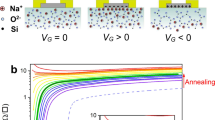Abstract
Superconductivity in electron-doped C60 was first observed almost ten years ago. The metallic state and superconductivity result from the transfer of electrons from alkaline or alkaline-earth ions to the C60 molecule, which is known to be a strong electron acceptor. For this reason, it is very difficult to remove electrons from C60—yet one might expect to see superconductivity at higher temperatures in hole-doped than in electron-doped C60, because of the higher density of electronic states in the valence band than in the conduction band. We have used the technique of gate-induced doping in a field-effect transistor configuration to introduce significant densities of holes into C60. We observe superconductivity over an extended range of hole density, with a smoothly varying transition temperature Tc that peaks at 52 K. By comparison with the well established dependence of Tc on the lattice parameter in electron-doped C60, we anticipate that Tc values significantly in excess of 100 K should be achievable in a suitably expanded, hole-doped C60 lattice.







Similar content being viewed by others
References
Seitz, F. & Turnbull, D. Solid State Physics Vol. 48 (eds Ehrenreich, H. & Spaepen, F.) (Academic, San Diego, 1994).
Ramirez, A. P. C60 and its superconductivity. Supercond. Rev. 1, 1–101 (1994).
Gunnarsson, O. Superconductivity in fullerides. Rev. Mod. Phys. 69, 575–606 (1997).
Hebard, A. F. et al. Superconductivity at 18 K in potassium-doped C60. Nature 350, 600–601 (1991).
Varma, C. M., Zaanen, J. & Raghavachari, K. Superconductivity in the fullerenes. Science 254, 989–992 (1991).
Erwin, S. C. in Buckminsterfullerenes (eds Billups, W. E. & Ciufolini, M. A.) 217–255 (VCH, New York, 1992).
Haddon, R. C., Siegrist, T., Fleming, R. M., Bridenbaugh, P. M. & Laudise, R. A. Band structures of organic thin-film transistor materials. J. Mater. Chem. 5, 1719–1724 (1995).
Mazin, I. I. et al. Quantitative theory of superconductivity in doped C60. Phys. Rev. B 45, 5114–5117 (1992).
Hirsch, J. E. Bond-charge repulsion and hole superconductivity. Physica C 158, 326–336 (1989).
Haddon, R. C. The fullerenes : powerful carbon-based electron acceptors. Phil. Trans. R. Soc. Lond. A 343, 53–62 (1993).
Reed, C. A., Kim, K. C., Bolskar, R. D. & Mueller, L. J. Taming superacids : stabilization of the fullerene cations HC+60 and C·+60. Science 289, 101–104 (2000).
Song, L. W., Fredette, K. T., Chung, D. D. L. & Kao, Y. H. Superconductivity in interhalogen-doped fullerenes. Solid State Commun. 87, 387–391 (1993).
Schön, J. H., Kloc, Ch., Haddon, R. C. & Batlogg, B. A superconducting field-effect switch. Science 288, 656–658 (2000).
Schön, J. H., Kloc, Ch. & Batlogg, B. Superconductivity in molecular crystals induced by charge injection. Nature 406, 704–706 (2000).
Kochanski, G. P., Hebard, A. F., Haddon, R. C. & Fiory, A. T. Electrical resistivity and stoichiometry of KxC60 films. Science 255, 184–186 (1992).
Rosseinsky, M. J. Recent developments in the chemistry and physics of metal fullerides. Chem. Mater. 10, 2665–2685 (1998).
Han, J. E., Koch, E. & Gunnarsson, O. Metal-insulator transitions : influence of lattice structure, Jahn-Teller effect, and Hund's Rule coupling. Phys. Rev. Lett. 84, 1276–1279 (2000).
Kloc, Ch., Simpkins, P. G., Siegrist, T. & Laudise, R. A. Physical vapor growth of centimeter-sized crystals of α-hexathiophene. J. Cryst. Growth 182, 416–427 (1997).
Dodabalapur, A., Torsi, L. & Katz, H. E. Organic transistors : two-dimensional transport and improved electrical characteristics. Science 268, 270–271 (1995).
Yildirim, T. et al. Tc vs. carrier concentration in cubic fulleride superconductors. Phys. Rev. Lett. 77, 167–170 (1996).
Heiney, P. A. et al. Discontinuous volume change at the orientational-ordering transition in solid C60. Phys. Rev. B 45, 4544–4547 (1992).
Hesper, R., Tjeng, L. H., Heeres, A. & Sawatzky, G. A. BCS-like density of states in superconducting A3C60 surfaces. Phys. Rev. Lett. 85, 1970–1973 (2000).
Klein, O., Grüner, G., Huang, S.-M., Wiley, J. B. & Kaner, R. B. Electrical resistivity of K3C60. Phys. Rev. B 46, 11247–11249 (1992).
Crespi, V. H., Hou, J. G., Xiang, X.-D., Cohen, M. L. & Zettl, A. Electron-scattering mechanisms in single-crystal K3C60. Phys. Rev. B 46, 12064–12067 (1992).
Vareka, W. A. & Zettl, A. Linear temperature dependent resistivity at constant volume in Rb3C60. Phys. Rev. Lett. 72, 4121–4124 (1994).
Acknowledgements
We thank E. A. Chandross and C. M. Varma for discussions, and E. Bucher for the use of his equipment.
Author information
Authors and Affiliations
Corresponding author
Rights and permissions
About this article
Cite this article
Schön, J., Kloc, C. & Batlogg, B. Superconductivity at 52 K in hole-doped C60. Nature 408, 549–552 (2000). https://doi.org/10.1038/35046008
Received:
Accepted:
Issue Date:
DOI: https://doi.org/10.1038/35046008
- Springer Nature Limited
This article is cited by
-
Light triggered encapsulation and release of C60 with a photoswitchable TPE-based supramolecular tweezers
Scientific Reports (2019)
-
Synthesis, characterization and charge storage properties of C60-fullerene microparticles as a flexible negative electrode for supercapacitors
Journal of Materials Science: Materials in Electronics (2019)
-
Cage connectivity and frontier π orbitals govern the relative stability of charged fullerene isomers
Nature Chemistry (2015)
-
Falsificationism Falsified
Foundations of Science (2006)
-
Studying the properties of carbon nanotubes with the functional integration method
Theoretical and Mathematical Physics (2006)





